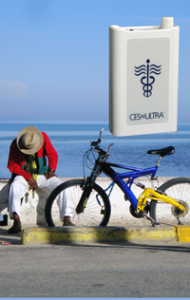from motherearthnews.com
By administering energy in controlled, coherent pulses, physicians can use electromagnetic pulse therapy to treat wounds, chronic pain, and alcoholism. While research supports the benefits of this type of therapy when performed by professional physicians using clinical instruments, it does not support claims that electrotherapy mats and home devices effectively treat soft tissue pain. This article, then, looks only at professionally administered therapies.
Wound Healing
Low-intensity direct current (LIDC) is safely administered by placing the electrodes from the LIDC instrument onto the surface of the skin. A very small amount of electric current flows in one direction to the site and creates a magnetic field around the wound. This creates an effect known as galvanotaxis, which causes fibroblasts and keratinocytes to travel to the wound and begin to heal tissue upon reaching the damaged area. In studies, this effect has been shown to increase the rate of healing by 100% to 150%. It also makes the resulting scar tissue more resistant to future damage.
In addition, LIDC has antimicrobial effects. In two studies, patients who received LIDC experienced no infections and less discomfort at their wound sites. Typically, treatment is administered for 60 minutes each day until the wound is healed.
Depression, Pain, and More…
 Cranial electrotherapy stimulation (CES) is another type of electric procedure approved by the FDA when administered by trained physicians and health providers. In this treatment for depression, insomnia, and anxiety, electrodes that are placed on the ears send a small electric current into the brain. This deactivates certain portions of the brain, which mitigates symptoms of neural imbalance and hyperactivity by controlling neurotransmitter release and neuron signaling patterns.
Cranial electrotherapy stimulation (CES) is another type of electric procedure approved by the FDA when administered by trained physicians and health providers. In this treatment for depression, insomnia, and anxiety, electrodes that are placed on the ears send a small electric current into the brain. This deactivates certain portions of the brain, which mitigates symptoms of neural imbalance and hyperactivity by controlling neurotransmitter release and neuron signaling patterns.
This deactivation has also been shown to reduce the pain symptoms of fibromyalgia. Patients using CES devices report that they experience a decrease in chronic pain, and MRI scans confirm that this is due to a deactivation of pain signaling in the brain.[8] Fibromyalgia patients using CES have been shown to experience a 28% reduction in tenderness, a 27% reduction in pain intensity, and a 55% improvement in quality of sleep. Similarly, patients who use CES therapy for spinal cord injuries report a significant decrease in pain intensity.
Alcoholism
CES has also been used to treat the symptoms of alcohol withdrawal. Studies show that CES can help alcoholics to reduce their alcohol consumption as well as the stress and depression associated with quitting. The treatment plan consists of daily 30-minute sessions over a period of four weeks. Additional studies indicate that the calming effect of CES also reduces anxiety symptoms in alcoholics.
How To Find Effective Electrotherapy
This discussion of electrotherapy comes with two important caveats. The first is that home use electrotherapy mats are not proven to be effective at relieving soft tissue pain. The pain relief described here is a result of direct current being applied to the brain by clinical CES devices that are operated by physicians. Mats are not shown to achieve this result.
The second important note is that CES shuts down parts of the brain. This makes it an effective method for relieving symptoms, but like medication, it is not a cure or remedy. The advantage that CES has over medication is that CES does not elicit side effects. As FDA-approved treatments, LIDC and CES are available at clinics that specialize in trauma therapy and rehabilitation, and are likely to be covered by most insurance companies. Natural Health Advisory Institute has a searchable physician or practitioner directory where those practicing electrostimulation therapy can be located.
